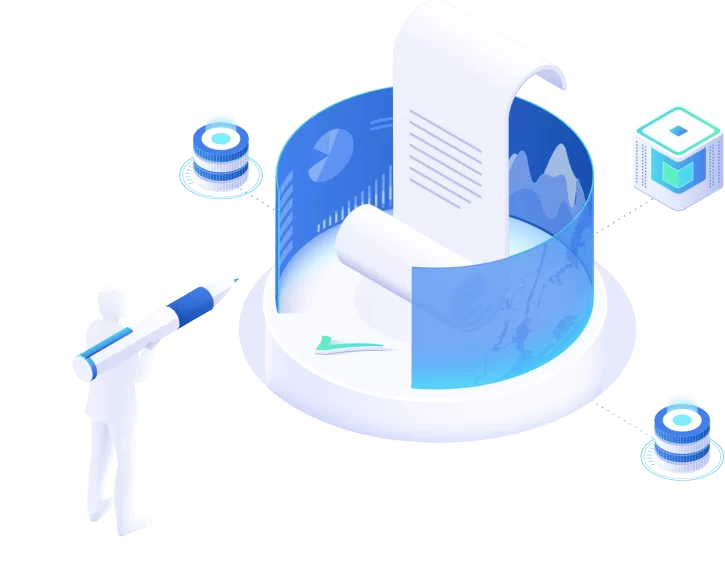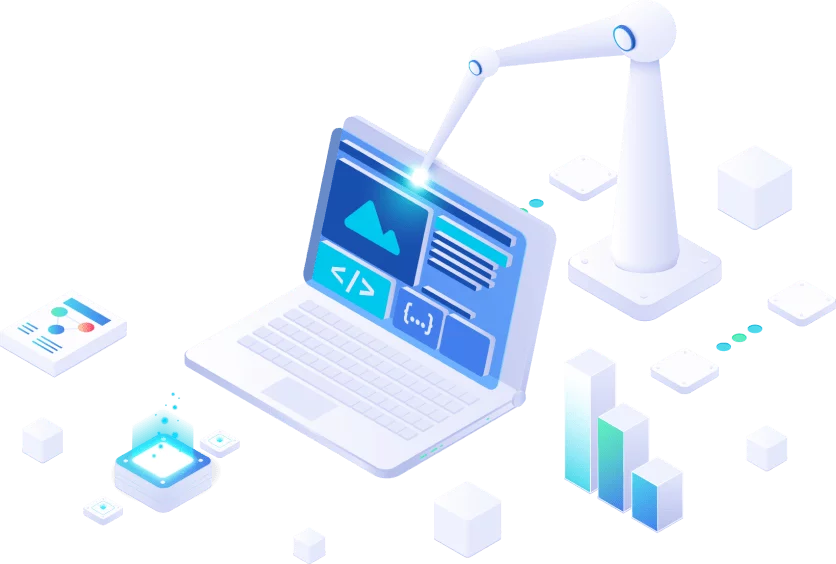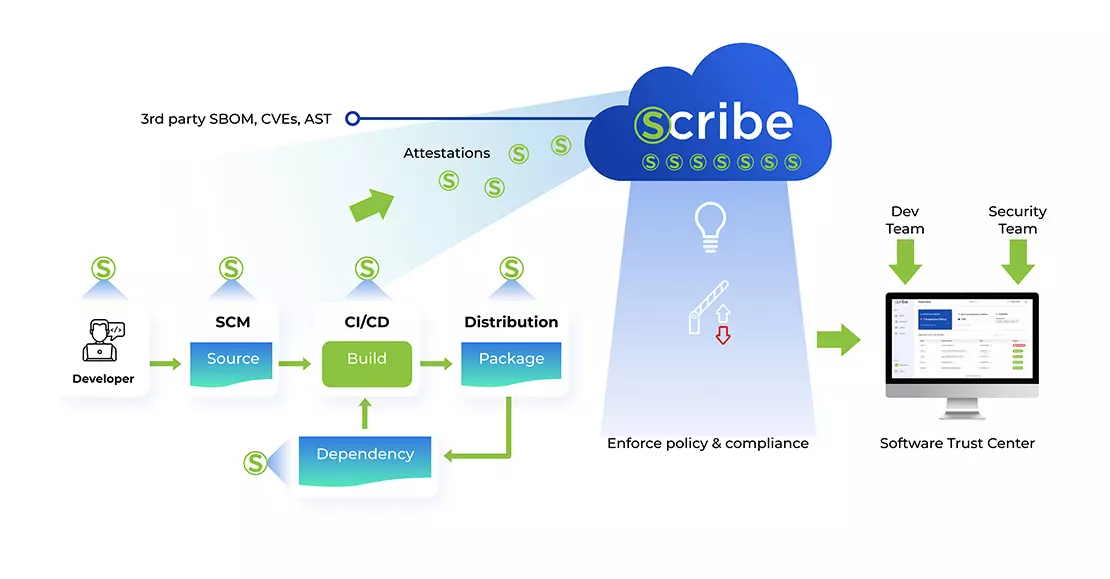SCRIBE vs. ASPM: A Unified Approach to Application and Supply Chain Security
Is ASPM enough to protect software development?
Application Security Posture Management (ASPM) tools are primarily designed to consolidate and manage application-layer security by aggregating outputs from tools like SCA, SAST, and DAST. While ASPM tools may include features for securing aspects of the SDLC, their focus often remains limited to application visibility and static policy enforcement. ASPM solutions rarely extend their capabilities to comprehensively protect the broader software supply chain, including pipelines, build systems, and deployment processes.
Scribe Security’s Comprehensive Approach to ASPM and Supply Chain Security

An end-to-end contextual and evidence-based approach
Scribe employs a flexible array of sensors to collect detailed security evidence across the SDLC, providing a comprehensive and contextual view of product releases and deployments. Each product release and associated artifacts are accompanied by a detailed dossier containing evidence such as the product tree, SBOMs of source code repositories and container images, security configurations of development tools, vulnerability scan results, file hashes, and code or artifact signature verifications. Organizations can tailor their setup by choosing lightweight API-based sensors for high-level insights or in-depth agents for more detailed analysis, aligning with their maturity level and needs.

Policy-Driven SDLC Guardrails
Scribe empowers organizations to create and enforce custom security policies aligned with their unique requirements. These policies can be flexibly applied across various SDLC stages, including development, build, and deployment, functioning as real-time gates to monitor and mitigate risks based on cumulative evidence. By leveraging GitOps for version control and seamless integration, Scribe ensures flexible, adaptable policy enforcement that meets the demands of complex, real-world environments.

Compliance as Code
Scribe integrates compliance workflows directly into the SDLC as code, enabling organizations to adhere to frameworks such as SLSA, SSDF, and EO 14028. These guardrails are embedded into the SDLC and supported by continuous attestation, allowing teams to measure progress, adopt policies, and flexibly evolve compliance initiatives. This iterative approach ensures long-term alignment with regulatory and organizational requirements.

Comprehensive Asset Discovery and Monitoring
Scribe provides comprehensive asset discovery by mapping all development assets, pipelines, dependencies, and their relationships across the SDLC. This visibility enables security teams to manage risks proactively, track configurations, monitor code lineage, and ensure artifact integrity from development to production. Scribe enhances situational awareness and facilitates informed decision-making by delivering a complete picture of the software factory.

Advanced SBOM Management and Transparency
Scribe’s analytics engine delivers in-depth, customizable insights into software risks while tracking key performance indicators (KPIs) for DevSecOps. By highlighting trends and pinpointing gaps in security posture, these analytics support continuous improvement efforts and help organizations benchmark their progress across the SDLC.

Advanced Analytics and Performance KPIs
Scribe’s analytics engine tracks DevSecOps performance and provides actionable insights into security KPIs across the SDLC. This capability helps organizations continuously improve their security posture while identifying areas for enhancement.

Vulnerability and Risk Management with VEX Advisory Management
Scribe’s VEX (Vulnerability Exploitability eXchange) advisory management enhances post-release risk management by generating context-aware advisories based on SBOM inventories. It tracks new vulnerabilities and alerts stakeholders, ensuring timely updates for risk mitigation. This proactive approach bridges the gap between software producers and consumers, contributing to transparent communication and effective vulnerability handling.

Anti-Tampering Controls and Continuous Code Signing
Scribe integrates anti-tampering protections, automated code signing, and continuous attestation to safeguard software integrity from development through deployment. These capabilities ensure that every artifact remains tamper-proof and verifiable, enhancing the trustworthiness of the entire software lifecycle and protecting against malicious alterations
Scribe’s Enhanced ASPM Capabilities Compared to Typical ASPM Tools
| Feature | Scribe Security | Typical ASPM | Advantage |
| An End-to-End Contextual and Evidence-Based Approach | Collects security evidence across the SDLC with flexible sensors, creating a contextual view of product releases. Includes detailed dossiers with SBOMs, security configurations, vulnerability scans, and artifact verification. | Primarily focuses on aggregating security tool outputs, without creating a comprehensive, evidence-rich context for releases. | Provides organizations with actionable, evidence-backed insights for better supply chain risk management and product security assessments. |
| Policy-Driven SDLC Guardrails | Enables custom security policies across all SDLC stages, acting as real-time gates based on cumulative evidence. Integrates with GitOps for seamless and adaptive policy management. | Limited to static policy checks focused on application-layer vulnerabilities. | Offers flexible, real-time policy enforcement adaptable to evolving organizational needs and complex environments. |
| Compliance as Code | Integrates compliance workflows as code within the SDLC, supporting frameworks like SLSA, SSDF, and EO 14028. Includes attestation for progress tracking and iterative improvement. | elies on static compliance reporting without iterative or flexible adoption workflows. | Supports real-world compliance alignment and continuous evolution of compliance initiatives, ensuring organizations meet regulatory requirements effectively. |
| Comprehensive Asset Discovery and Monitoring | Maps all development assets, pipelines, dependencies, and relationships, delivering a complete view of the software factory. | Focused on application-layer visibility with minimal supply chain asset mapping. | Enhances situational awareness, proactive risk management, and informed decision-making by providing a holistic view of the SDLC. |
| Advanced SBOM Management and Transparency | Generates, signs, and updates SBOMs at every SDLC stage, creating product-aware inventories. Allows sharing of verifiable transparency data with consumers. | Provides static SBOM snapshots without continuous tracking or transparency mechanisms. | Ensures real-time SBOM updates and fosters trust by enabling compliance and clear communication with software consumers. |
| Advanced Analytics and Performance KPIs | Tracks security KPIs and DevSecOps performance across the SDLC with actionable insights for continuous improvement. | Offers basic vulnerability reports without broader KPI tracking. | Identifies trends and gaps in security posture, helping organizations benchmark and improve DevSecOps performance. |
| Vulnerability and Risk Management with VEX Advisory Management | Generates context-aware VEX advisories for post-release risk management and tracks new vulnerabilities against SBOM inventories. | Lacks post-release risk management and advisory capabilities. | Proactively manages and communicates risks to stakeholders, bridging gaps between software producers and consumers. |
| Anti-Tampering Controls and Code Signing | Includes tamper-proofing protections, automated code signing, and continuous attestation to secure artifacts. | Focuses on vulnerability detection without tamper-proofing or artifact integrity features. | Ensures software integrity and provenance across the entire SDLC, protecting against malicious modifications and enhancing trustworthiness. |

ASPM tools focus on application-layer security, aggregating outputs from tools like SCA and SAST, but often lack comprehensive supply chain security, including pipelines and build systems.
Scribe Security expands beyond application security by addressing risks across the entire SDLC. It uses customizable sensors to collect contextual evidence, such as SBOMs, scan results, and artifact signatures, creating detailed security dossiers for product releases.
Scribe supports policy-driven SDLC governance with real-time security gates that adapt to organizational needs using GitOps. Compliance workflows are integrated as code, supporting frameworks like SLSA and EO 14028, with continuous attestation for progress tracking.
Its capabilities include asset discovery across the software factory, advanced SBOM management for lifecycle transparency, analytics to track DevSecOps performance, and VEX advisory management for post-release risk communication. Anti-tampering controls, code signing, and attestation ensure artifact integrity throughout the SDLC.
Scribe addresses ASPM’s limitations by unifying application and supply chain security with flexible, compliance-focused workflows.
